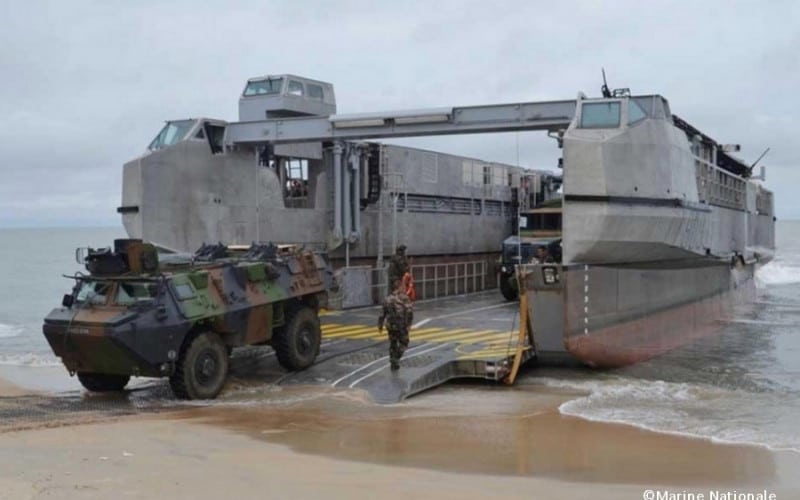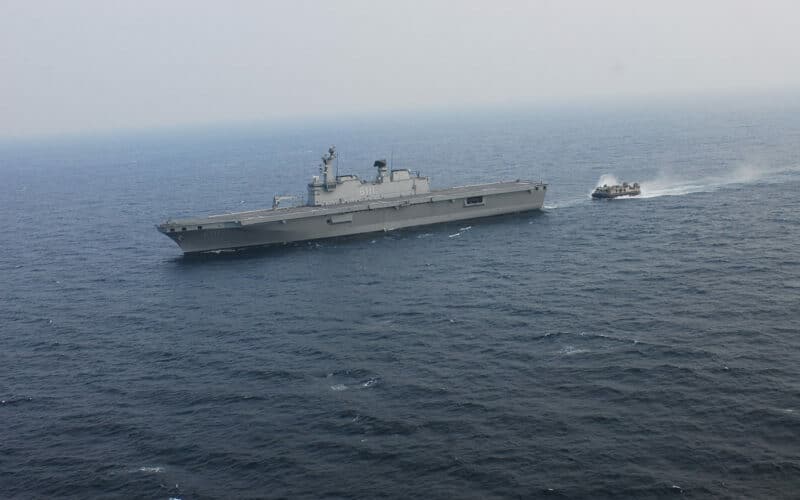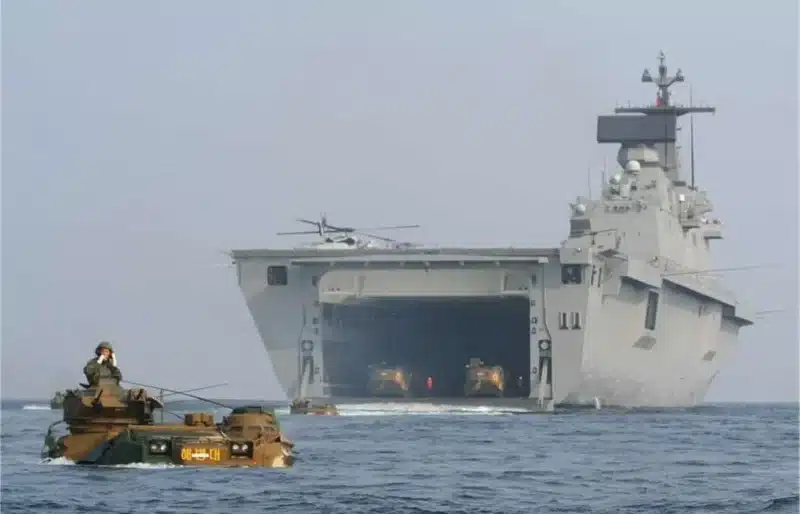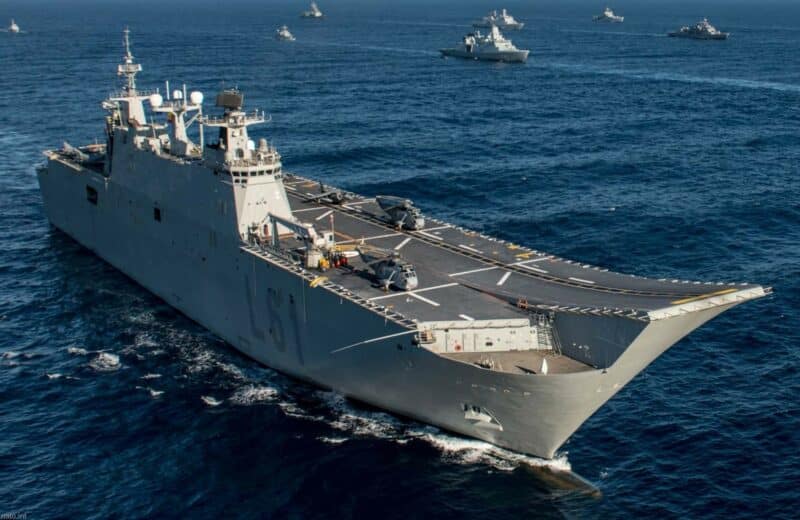In this section:
As we saw in the first part of this article, the assault helicopter carriers, a hybrid ship combining a powerful naval air capability with a straight flight deck and a large hangar allowing the implementation of a fleet of maneuver and combat helicopters, as well as a amphibious capacity through a raft that can accommodate landing craft or assault hovercraft, appeared to respond to the proliferation of coastal batteries equipped with anti-ship missiles capable of targeting any ship above the sea. 'horizon.
However, if the electromagnetic horizon constitutes an effective protection against this type of threat, it imposes a most significant constraint, having led to the design of this type of ship. The latter must indeed carry out his assault operation while remaining more than 40 km from the landing site.
Although such a distance has little influence on the course of the first wave of the assault, it constitutes a considerable constraint for the rest of the operation, while a barge moving at 15 knots will take almost five hours to rotate. to load and bring back to the landing site the reinforcements and ammunition necessary to support the amphibious assault.
It is precisely to deal with this constraint that the LHD (Landing Helicopter Deck) type assault helicopter carriers have appeared. Like the LPDs (Landing Platform Deck), they indeed implement landing barges, or better, hovercraft capable of performing rotations in just over two hours.
Above all, the support and reinforcement of the bridgehead units are carried out not with the help of barges, but of the fleet of helicopters capable of bringing men and ammunition to the beach, but also of evacuating the wounded. to the ship, with rotations of less than 30 minutes.
As for barges or hovercraft, their main function is to bring vehicles and freight too heavy to be transported by a helicopter. The entire architecture of the assault helicopter carriers stems from this context, so as to give the assault forces a high operational intensity while remaining under the protection of the horizon.

In the first part of this article, we presented the US Navy's America class assault helicopter carriers, the Chinese Type 075, the French Mistral as well as the Italian Trieste. In this second part, we will discuss the South Korean Dokdo-class LHDs, the very prolific concept of the Spanish Juan Carlos I assault aircraft carrier, the new Turkish Anadolu assault drone carrier as well as the future helicopter carriers Project 23900 Ivan Rogov-class Russian assault ships.
South Korean: Dokdo-class assault helicopter carrier
Offensive ship par excellence, the assault helicopter carrier primarily equips navies with power projection ambitions. But this is not the case with the two LHDs of the Dokdo class.
Indeed, these ships were designed not to give the South Korean Navy a long-range intervention capability, but to offer the country's armed forces new defensive options in the face of its tumultuous northern neighbor. It must be said that, in this area, Seoul has, so to speak, been in a good school.
As United Nations forces were cornered in the Busan pocket by the North Korean offensive in the late summer of 1950, General MacArthur set up Operation Chromite, a very daring amphibious landing in Incheon, near Seoul, to take the North Korean armies from behind.
Launched on September 15, 1950, the operation mobilized 230 ships, including several aircraft carriers, and made it possible to land more than 40.000 men of the American Xᵉ corps a few kilometers from the capital, cutting the enemy's supply lines. , and reversing the tide of the war, at least until China entered the war.

The example of the Incheon landing influenced South Korean strategists, who decided, at the end of the 90s, to equip their Navy in full modernization with two large assault helicopter carriers capable of operating under cover of the horizon, the Dokdo class, to protect itself from the threat of the very numerous coastal batteries implemented by Pyongyang.
In addition to the two planned LHDs, South Korean engineers simultaneously developed a model of assault hovercraft, the Solgae class, specially designed to arm the Dokdo and give them significant rotation capacity. The first assault helicopter carrier of the class, the Dokdo, entered service in 2007, just like the first hovercraft of the Solgae class, but it will be necessary to wait until 2021 for the second unit, the Marado, to also join the South Korean Navy.
199 meters long, the Dokdo only have a laden displacement of 19.000 tonnes. They are also economical, with a unit price of less than $300m. However, they can transport an assault force of 720 Marines and 30 vehicles including 10 tanks, and simultaneously deploy 2 Solgae class hovercraft as well as about fifteen UH-60, UH-1 or super Lynx helicopters.
The vehicle transport capacity can be greatly increased if no helicopter is present in the aviation hangar. On the other hand, the Dokdo bridge can accommodate heavy aircraft such as the MV-22 Osprey, it cannot, however, implement vertical take-off aircraft such as the F-35B.

To obtain such capacities on such a small hull, the South Korean engineers had to significantly cut back on the ship's nautical performance, and in particular on its endurance at sea.
However, in view of its planned use of these ships, whose doctrine requires that they be implemented within a naval force composed of a Dokdo, two heavy destroyers of the Sejong le Grand class, from several escort destroyers and frigates, as well as submarines and several Gwanggaeto the Great class landing ships, the ship appears well sized and designed.
As the South Korean Navy is very poorly equipped with logistics ships, and particularly large-capacity supply tankers, it is obvious that these fleets only have a regional operational scope. Furthermore, unlike Japan which decided to modernize its two Izumo class helicopter carriers to accommodate F-35Bs, South Korea turned to the design of an aircraft carrier dedicated to this function. .
Spain: Juan Carlos 1 class aircraft carrier
At the end of the 60s, Spain undertook to provide its navy with naval air capability, by negotiating the lease of the American light aircraft carrier USS Cabot of the Independence class. Entering service in 1943, the ship had been mothballed for twenty years. Initially intended to implement SH-3 Sea King helicopters, the ship baptized Dedalo was purchased by Madrid in 1972 and then modernized to accommodate the new AV-8s Matador with vertical take-off and landing.

75% of this article remains to read,
Subscribe to access it!
The Classic subscriptions provide access to
articles in their full version, and without advertising,
from 6,90 €.
Newsletter subscription
Register for the Meta-Defense Newsletter to receive the
latest fashion articles daily or weekly


[…] Γάλλοι: Τα TCG Anadolu και TCG Trackya αλλάζουν τις ισορροπίες στην Ανατολική Μεσόγειο υ περ της Τουρκίας, υποστηρίζει το γαλλικό αμυντικό σάιτ meta-defense.fr. [...]
[…] […]